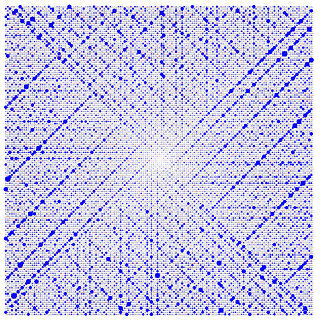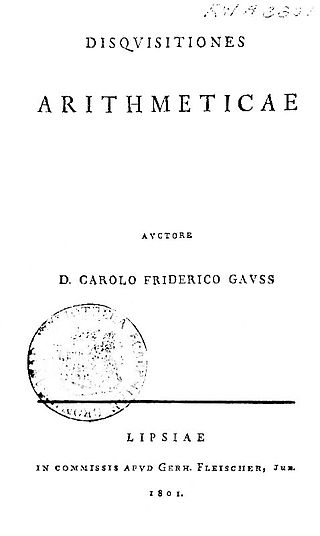
In mathematics, a Diophantine equation is an equation, typically a polynomial equation in two or more unknowns with integer coefficients, for which only integer solutions are of interest. A linear Diophantine equation equates to a constant the sum of two or more monomials, each of degree one. An exponential Diophantine equation is one in which unknowns can appear in exponents.
In mathematics, an equation is a mathematical formula that expresses the equality of two expressions, by connecting them with the equals sign =. The word equation and its cognates in other languages may have subtly different meanings; for example, in French an équation is defined as containing one or more variables, while in English, any well-formed formula consisting of two expressions related with an equals sign is an equation.

Number theory is a branch of pure mathematics devoted primarily to the study of the integers and arithmetic functions. German mathematician Carl Friedrich Gauss (1777–1855) said, "Mathematics is the queen of the sciences—and number theory is the queen of mathematics." Number theorists study prime numbers as well as the properties of mathematical objects constructed from integers, or defined as generalizations of the integers.

In number theory, the law of quadratic reciprocity is a theorem about modular arithmetic that gives conditions for the solvability of quadratic equations modulo prime numbers. Due to its subtlety, it has many formulations, but the most standard statement is:
Hilbert's tenth problem is the tenth on the list of mathematical problems that the German mathematician David Hilbert posed in 1900. It is the challenge to provide a general algorithm that, for any given Diophantine equation, can decide whether the equation has a solution with all unknowns taking integer values.

Algebraic number theory is a branch of number theory that uses the techniques of abstract algebra to study the integers, rational numbers, and their generalizations. Number-theoretic questions are expressed in terms of properties of algebraic objects such as algebraic number fields and their rings of integers, finite fields, and function fields. These properties, such as whether a ring admits unique factorization, the behavior of ideals, and the Galois groups of fields, can resolve questions of primary importance in number theory, like the existence of solutions to Diophantine equations.

In physical science and mathematics, the Legendre functionsPλ, Qλ and associated Legendre functionsPμ
λ, Qμ
λ, and Legendre functions of the second kind, Qn, are all solutions of Legendre's differential equation. The Legendre polynomials and the associated Legendre polynomials are also solutions of the differential equation in special cases, which, by virtue of being polynomials, have a large number of additional properties, mathematical structure, and applications. For these polynomial solutions, see the separate Wikipedia articles.

In number theory, the study of Diophantine approximation deals with the approximation of real numbers by rational numbers. It is named after Diophantus of Alexandria.
In mathematics, a proof by infinite descent, also known as Fermat's method of descent, is a particular kind of proof by contradiction used to show that a statement cannot possibly hold for any number, by showing that if the statement were to hold for a number, then the same would be true for a smaller number, leading to an infinite descent and ultimately a contradiction. It is a method which relies on the well-ordering principle, and is often used to show that a given equation, such as a Diophantine equation, has no solutions.
In mathematics, an algebraic equation or polynomial equation is an equation of the form , where P is a polynomial with coefficients in some field, often the field of the rational numbers. For example, is an algebraic equation with integer coefficients and

In mathematics, to solve an equation is to find its solutions, which are the values that fulfill the condition stated by the equation, consisting generally of two expressions related by an equals sign. When seeking a solution, one or more variables are designated as unknowns. A solution is an assignment of values to the unknown variables that makes the equality in the equation true. In other words, a solution is a value or a collection of values such that, when substituted for the unknowns, the equation becomes an equality. A solution of an equation is often called a root of the equation, particularly but not only for polynomial equations. The set of all solutions of an equation is its solution set.
The Beal conjecture is the following conjecture in number theory:
In number theory, Dirichlet's theorem on Diophantine approximation, also called Dirichlet's approximation theorem, states that for any real numbers and , with , there exist integers and such that and

A Pythagorean quadruple is a tuple of integers a, b, c, and d, such that a2 + b2 + c2 = d2. They are solutions of a Diophantine equation and often only positive integer values are considered. However, to provide a more complete geometric interpretation, the integer values can be allowed to be negative and zero (thus allowing Pythagorean triples to be included) with the only condition being that d > 0. In this setting, a Pythagorean quadruple (a, b, c, d) defines a cuboid with integer side lengths |a|, |b|, and |c|, whose space diagonal has integer length d; with this interpretation, Pythagorean quadruples are thus also called Pythagorean boxes. In this article we will assume, unless otherwise stated, that the values of a Pythagorean quadruple are all positive integers.
In mathematics and statistics, sums of powers occur in a number of contexts:

In number theory, Fermat's Last Theorem states that no three positive integers a, b, and c satisfy the equation an + bn = cn for any integer value of n greater than 2. The cases n = 1 and n = 2 have been known since antiquity to have infinitely many solutions.
Fermat's Last Theorem is a theorem in number theory, originally stated by Pierre de Fermat in 1637 and proven by Andrew Wiles in 1995. The statement of the theorem involves an integer exponent n larger than 2. In the centuries following the initial statement of the result and before its general proof, various proofs were devised for particular values of the exponent n. Several of these proofs are described below, including Fermat's proof in the case n = 4, which is an early example of the method of infinite descent.

Fermat's right triangle theorem is a non-existence proof in number theory, published in 1670 among the works of Pierre de Fermat, soon after his death. It is the only complete proof given by Fermat. It has many equivalent formulations, one of which was stated in 1225 by Fibonacci. In its geometric forms, it states:
Kuṭṭaka is an algorithm for finding integer solutions of linear Diophantine equations. A linear Diophantine equation is an equation of the form ax + by = c where x and y are unknown quantities and a, b, and c are known quantities with integer values. The algorithm was originally invented by the Indian astronomer-mathematician Āryabhaṭa and is described very briefly in his Āryabhaṭīya. Āryabhaṭa did not give the algorithm the name Kuṭṭaka, and his description of the method was mostly obscure and incomprehensible. It was Bhāskara I who gave a detailed description of the algorithm with several examples from astronomy in his Āryabhatiyabhāṣya, who gave the algorithm the name Kuṭṭaka. In Sanskrit, the word Kuṭṭaka means pulverization, and it indicates the nature of the algorithm. The algorithm in essence is a process where the coefficients in a given linear Diophantine equation are broken up into smaller numbers to get a linear Diophantine equation with smaller coefficients. In general, it is easy to find integer solutions of linear Diophantine equations with small coefficients. From a solution to the reduced equation, a solution to the original equation can be determined. Many Indian mathematicians after Aryabhaṭa have discussed the Kuṭṭaka method with variations and refinements. The Kuṭṭaka method was considered to be so important that the entire subject of algebra used to be called Kuṭṭaka-ganita or simply Kuṭṭaka. Sometimes the subject of solving linear Diophantine equations is also called Kuṭṭaka.
This is a glossary of concepts and results in number theory, a field of mathematics. Concepts and results in arithmetic geometry and diophantine geometry can be found in Glossary of arithmetic and diophantine geometry.









